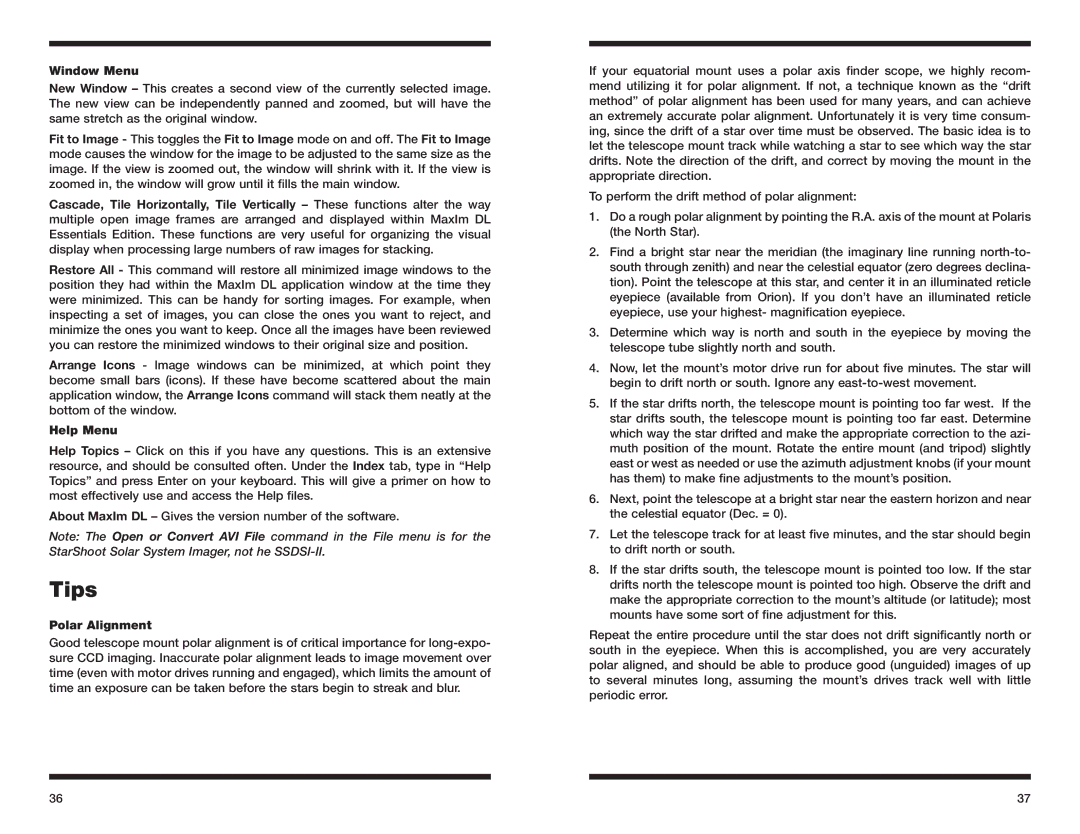
Window Menu
New Window – This creates a second view of the currently selected image. The new view can be independently panned and zoomed, but will have the same stretch as the original window.
Fit to Image - This toggles the Fit to Image mode on and off. The Fit to Image mode causes the window for the image to be adjusted to the same size as the image. If the view is zoomed out, the window will shrink with it. If the view is zoomed in, the window will grow until it fills the main window.
Cascade, Tile Horizontally, Tile Vertically – These functions alter the way multiple open image frames are arranged and displayed within MaxIm DL Essentials Edition. These functions are very useful for organizing the visual display when processing large numbers of raw images for stacking.
Restore All - This command will restore all minimized image windows to the position they had within the MaxIm DL application window at the time they were minimized. This can be handy for sorting images. For example, when inspecting a set of images, you can close the ones you want to reject, and minimize the ones you want to keep. Once all the images have been reviewed you can restore the minimized windows to their original size and position.
Arrange Icons - Image windows can be minimized, at which point they become small bars (icons). If these have become scattered about the main application window, the Arrange Icons command will stack them neatly at the bottom of the window.
Help Menu
Help Topics – Click on this if you have any questions. This is an extensive resource, and should be consulted often. Under the Index tab, type in “Help Topics” and press Enter on your keyboard. This will give a primer on how to most effectively use and access the Help files.
About MaxIm DL – Gives the version number of the software.
Note: The Open or Convert AVI File command in the File menu is for the StarShoot Solar System Imager, not he
Tips
Polar Alignment
Good telescope mount polar alignment is of critical importance for
If your equatorial mount uses a polar axis finder scope, we highly recom- mend utilizing it for polar alignment. If not, a technique known as the “drift method” of polar alignment has been used for many years, and can achieve an extremely accurate polar alignment. Unfortunately it is very time consum- ing, since the drift of a star over time must be observed. The basic idea is to let the telescope mount track while watching a star to see which way the star drifts. Note the direction of the drift, and correct by moving the mount in the appropriate direction.
To perform the drift method of polar alignment:
1.Do a rough polar alignment by pointing the R.A. axis of the mount at Polaris (the North Star).
2.Find a bright star near the meridian (the imaginary line running
3.Determine which way is north and south in the eyepiece by moving the telescope tube slightly north and south.
4.Now, let the mount’s motor drive run for about five minutes. The star will begin to drift north or south. Ignore any
5.If the star drifts north, the telescope mount is pointing too far west. If the star drifts south, the telescope mount is pointing too far east. Determine which way the star drifted and make the appropriate correction to the azi- muth position of the mount. Rotate the entire mount (and tripod) slightly east or west as needed or use the azimuth adjustment knobs (if your mount has them) to make fine adjustments to the mount’s position.
6.Next, point the telescope at a bright star near the eastern horizon and near the celestial equator (Dec. = 0).
7.Let the telescope track for at least five minutes, and the star should begin to drift north or south.
8.If the star drifts south, the telescope mount is pointed too low. If the star drifts north the telescope mount is pointed too high. Observe the drift and make the appropriate correction to the mount’s altitude (or latitude); most mounts have some sort of fine adjustment for this.
Repeat the entire procedure until the star does not drift significantly north or south in the eyepiece. When this is accomplished, you are very accurately polar aligned, and should be able to produce good (unguided) images of up to several minutes long, assuming the mount’s drives track well with little periodic error.
36 | 37 |
